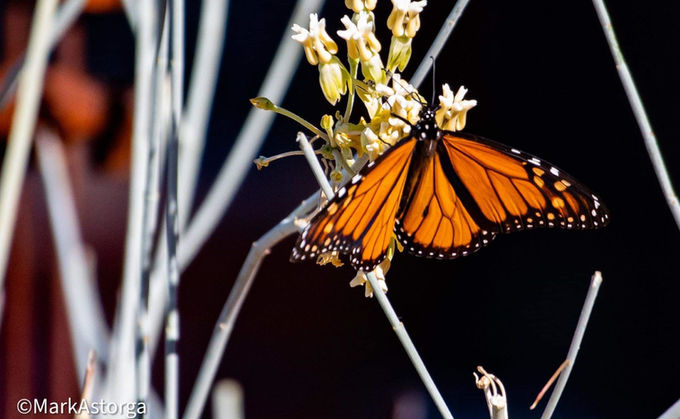Nursery Hours for October-March
Thursday-Saturday: 9:00-5:00 • Wednesday/Sunday: By Appointment
🌲🌲🌲Holiday Schedule🌲🌲🌲
Thanksgiving: Thursday & Friday CLOSED • Saturday OPEN 9:00-5:00
Christmas: 12/23/2025-01/07/2026 CLOSED
Need a gift for the plant person in your life? We have gift cards!
Rush or Desert Milkweed
Asclepias subulata
true
1 gallon; 5 gallon
Rush or Desert Milkweed
In stock
4’x4’
Sizes:
Rush Milkweed — Asclepias subulata
Also known as: Desert Milkweed
Rush Milkweed is our local native milkweed, found naturally in the Colorado Desert, as well as other parts of the Sonoran and Mojave Deserts. It typically grows in dry washes and on rocky slopes, forming an erect, reed-like structure made up of densely packed gray-green stems with few or no leaves. Its tidy form adds clean vertical lines to desert gardens.
From spring through fall, Rush Milkweed produces clusters of pale, creamy yellow flowers that attract butterflies, hawk moths, native bees, and other pollinators. These blooms are followed by upright seed pods that split open to release silky seeds into the wind.
Rush Milkweed is ideal for desert landscapes, thriving in full sun, reflected heat, and lean, well-drained soils. It performs especially well in poolside plantings and modern xeriscapes. While highly drought-tolerant, it will benefit from occasional supplemental irrigation in the hottest months.
Because monarch caterpillars feed exclusively on milkweed species, it’s important to plant several together and provide surrounding nectar-rich plants to attract adult butterflies. For best results as a host plant, group at least three Rush Milkweed in the same area.
Wildlife Value
Host Plant: Monarch (Danaus plexippus); Queen (Danaus gilippus)
Nectar Source: Monarch (Danaus plexippus); Queen (Danaus gilippus); Ceraunus Blue (Hemiargus ceraunus); Western Giant Swallowtail (Heraclides rumiko); Tarantula Hawk Wasp (Pepsis spp.)
Bird Resources: Caterpillars; Insects; Seeds; Nectar
Bird Species: Anna’s Hummingbird (Calypte anna); Costa’s Hummingbird (Calypte costae); Hooded Oriole (Icterus cucullatus)
Bees: Attracts native bees (especially from the genera Bombus, Xylocopa, and Diadasia); also visited by European Honey Bee (Apis mellifera)
Other Wildlife: Beetles
Plant Care
Native region:
Local Native; Mojave Desert
Water needs:
Low
Exposure:
Full Sun; Reflected Hear; Filtered Sun
Mature size:
4’x4’
Growth rate:
Moderate
Flower color:
Creamy Yellow
Flower season:
Spring; Summer; Fall
Pruning:
None required
Cold Hardiness:
20 Degrees
Nectar-producing:
Yes
Attracts pollinators:
Yes
Nighttime pollinators:
No
Butterflies or Moths:
Yes
Monarchs:
Yes
Larval host:
Yes
Bees:
Yes
Bats:
No
Birds:
Yes
Nest site:
No
Nest materials:
Yes
Rabbit-resistant:
Yes
Tortoises:
No
Growing Plants in the Desert — Important Information
The information presented here is, to the best of my knowledge, accurate and based on reliable research, personal experience in my own garden, observations from other gardens I’ve visited, and time spent studying plants in their native habitats. I always welcome your feedback and experiences to help me continue educating others!
Cacti:
In my experience, cacti are much happier in filtered shade here in the low desert of the Coachella Valley. Their colors are more vibrant and they tend to bloom more profusely, especially the non-native varieties. If you look closely at how our native barrel cactus and beavertail prickly pear grow in the wild, you’ll often find them tucked among rocks or beneath the shelter of creosote and other shrubs.
⚠️ A note of caution: Cacti and succulents are often illegally collected from the wild, which not only damages plant populations but also disturbs entire ecosystems. In some cases, wild populations of cacti have even gone extinct because of this practice. When purchasing these plants, always be sure they’ve been legally obtained. Look for nursery-grown stock or plants with a native plant certification, and keep that documentation for your records.
Light Requirements:
In our desert (Sonoran/Colorado), “full sun” doesn’t always mean what you might think. Many so-called full-sun plants benefit from and actually appreciate some late-afternoon filtered light—especially during the intense summer months.














